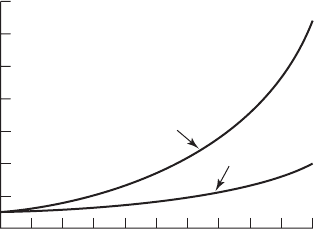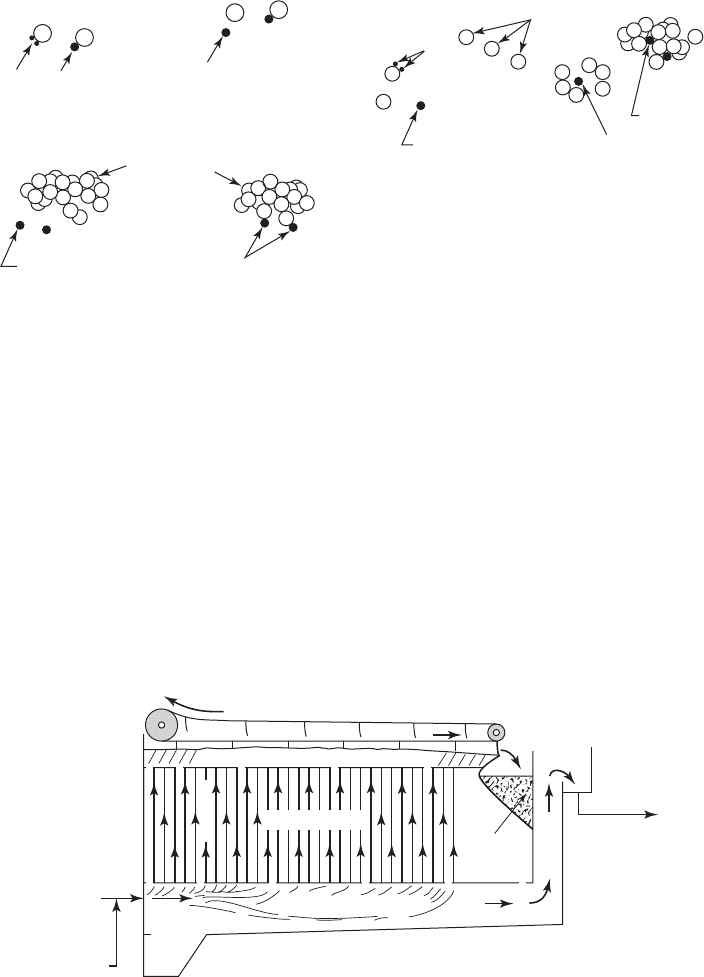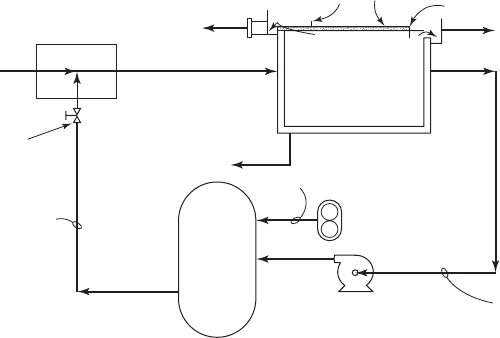Water and Wastewater Engineering
Подождите немного. Документ загружается.


WASTEWATER PLANT RESIDUALS MANAGEMENT 27-13
Type of pumpAdvantages Disadvantages
Plunger Can pump heavy solids concentrations (up to
15%)
Low efficiency
High maintenance if operated continuously
Self-priming and can handle suction lifts
up to 3 m
Depending on downstream processes, pulsating
flow may not be a
cceptable
Constant but adjustable capacity regardless of
variations in head
Cost-effective choice for flow rates up to 100
m
3
/h and heads up to 60 m
Pulsating action of simplex and duplex pumps
sometimes helps to concentrate sludge in
hoppers ahead of pumps and resuspend solids in
pipelines when pumping at low velocities
High-pressure capability
Progressing cavity Provides a relatively
smooth flow Stator will burn out if pump is operated dry;
needs a run dry protection system
Pumps greater than 10 m
3
/h capacity can pass
solids of about 20 mm in size
Smaller pumps usually require grinders to prevent
clogging
Easily controlled flow rates Power cost escalates when pumping heavy
sludge
Minimal pulsation
Relatively simple operation Grit in sludge may cause exc
essive stator
wear
Stator/rotor tends to act as a check valve, thus
preventing backflow through pump. An external
check valve may not be required
Seals and seal water required
Diaphragm Pulsating action may help to concentrate sludge
in hoppers ahead of pumps and resuspend
solids in pipelines when pumping at low
veloc
ities
Depending on downstream processes,
pulsating flow may not be acceptable
Requires a source of compressed air
Self-priming with suction lifts up to 3 m Operation may be excessively noisy
Can pump grit with relatively minimum wear Low head and efficiency
Relatively simple operation High m
aintenance if operated continuously
Centrifugal
nonclog
(mixed flow)
Has high volume and excellent efficiency for
activated-sludge pumping applications
Not recommended for other sludge pumping
applications because of potential clogging
due to rags and other debris
Relatively low cost
TABLE 27-5
Advantages and disadvantages of selected types of sludge pumps
Source: WEF, 1998.

27-14 WATER AND WASTEWATER ENGINEERING
Sludge. The headloss in pumping sludge depends on the flow properties (rheology) of the
sludge, pipe diameter, and the velocity of the sludge. A plot of shear stress versus rate of shear
at constant temperature and pressure illustrates examples of different rheological behavior
( Figure 27-5 ). Fluids following simple linearity (c
urve C) are called Newtonian fluids. Water is
a Newtonian fluid. Dilute sludges such as unconcentrated activated sludge and trickling-filter
sludges behave similar to water. Bingham plastics ( curve A) do not flow until a threshold shear
stress greater than
o
i s achieved. At shear stresses above
o
, the flow is nearly linear. Concen-
trated sludge has been found to behave much like a Bingham plastic.
With a 10 to 25 percent allowance for increased headloss, pumping calculations for
unconcentrated activated sludge and trickling-filter sludge are similar to those for water. Primary,
digested, and
concentrated s ludges exhibit Bingham plastic flow phenomenon. Onc e flow has
started, resistance increases approximately with the first power of the velocity through the lami-
nar range of flow to the lower critical velocity of about 1.1 m/s. Above the upper critical velocity
of about 1.4 m/s, the flow may be consid
ered turbulent.
Well-digested sludge flowing in the turbulent range m ay exhibit losses more than two to
three times the losses for water. The losses for polymer treated primary and concentrated slud-
ges may be considerably higher. Mixtures of scum and slud
ge exhibit losses similar to polymer
treated concentrated sludges.
Simplified Headloss Calculation. For short pipelines, U.S. EPA (1979) outlined a simplified
procedure for estimating headloss. The headloss is determined by multiplying the headloss deter-
mined for water by one of the standard techniq
ues (Darcy-Weisbach, Hazen-Williams, or Man-
ning equations) by the factor K determined from Figure 27-6 .
Shear stress,
o
Velocity gradient, du/dy
Bingham plastic
Pseudo-plastic
Newtonian
Dilatant
C
D
B
A
0
FIGURE 27-5
Shear stress versus velocity gradient for Newtonian and
non-Newtonian fluids. Examples are as follows: A sludge;
B rubber latex; C water; D quicksand
( Source: Adapted from McCabe et al., 2005.)

WASTEWATER PLANT RESIDUALS MANAGEMENT 27-15
This method should only be applied under the following conditions:
• Short sludge pipelines.
• Velocities 0.8 m/s but 2.4 m/s.
• Pipe is not obstructed with grease or other materials.
Thixotropic behavior (i.e., Bingham plastic) is not considered in this simplific
ation. Because sludge
lines within the treatment plant are usually short (usually 200 m), this technique is a practi-
cal method for estimating headloss if conservative friction losses are used. A Hazen-Williams C
of 100 has been used in EPA example calculations (U.S EPA, 1979).
Pumping Sludge over Long Distances. The Bingham plastic behavior of dige
sted biosolids,
thickened sludge, and concentrated activated sludge must be considered in the design of long
pipelines (for example, 1 km). Because of the specialized nature of these pipelines, their
design is not considered in this discussion. The read
er is referred to discussions in Metcalf &
Eddy (2003), Bechtel (2005), and Murakami et al. (2001) that present rheological methods for
estimating headloss.
The risk of underestimating the headloss increases as the piping distance and solids concen-
trations increase. Hydraulic
studies to confirm the ranges of headloss characteristics are strongly
recommended.
Sludge Piping
Sludge piping should not be less than 150 mm in diameter. Unless velocities exceed 1.5 to 1.8 m/s,
sludge piping is generally less than 200 mm in diameter. Gravity sludge withdrawal lines should
not be less than 200 mm diameter. Available head on gravity discharge pipe should be at least 1.2 m
(GLUMRB, 2004; Metc
alf & Eddy, 2003).
T ypic ally lined ductile iron pipe (DIP) is used for sludge-pipe material. Appropriately
pressure rated high density polyethylene (HDPE) pipe has also been used.
14
12
10
8
6
Untreated primary and
concentrated sludges
Digested
sludge
4
2
10 3 5
Sludge concentration, % solids by weight
Multiplication factor, K
678910
0
2 4
FIGURE 27-6
Approximate friction headloss for laminar flow of sludge.
NOTE: Multiply loss with clean water by K to estimate friction
loss under laminar conditions.
( Source: U.S. EPA, 1979.)

27-16 WATER AND WASTEWATER ENGINEERING
Stoppages in sludge pipelines are a major maintenance issue. Some suggested design features
are (Metcalf & Eddy, 2003):
• Plugged tees or crosses instead of elbows to facilitate the use of a rod to remove stoppages.
• Pump connections not less than 100 mm diameter.
• Ample number of flushing connections in the piping.
• Flushing water (plant effluent) at a capacity of not less than 36 m
3
/h and 500 kPa.
• In large plants with larger piping, provide greater capacity and pressure of 700 kPa.
Hints from the Field
Plant operation and maintenance personnel have provided the following insights on the design of
grit and sludge pipelines:
• Place grit pipes at locations that allow maintenance workers to stand at ground level.
• If overhead piping cannot be avoided, provide adequate floor space for maneuvering aerial
work platforms (also known as electric boom lifts or electric scissors ).
• Provide q
uick disconnects for grit pipes so they can be removed to clear stoppages.
• Make primary and concentrated sludge pipelines as short as possible. One hundred meters
of pipeline seems like a hundred kilometers of pipeline when it becomes plugged.
• A ssume that s
ludge pumping will be done over short time periods rather than over a 24-hour
period or even an 8-hour shift.
• Provide for reverse flow through sludge pipes as a means of dislodging stoppages.
Example 27-2. The Omega Three activated sludge plant generates a peak sludge flow rate
of 270 m
3
/ d of a mixed primary and thickened waste activated sludge. The solids concentration
is 3.8%. One-third of the sludge is to be pum ped 200 m to a stabilization facility during each
shift. Select a pipe diameter and estimate the friction headloss. Assume a Hazen-Williams
C
100 and a pumping time of one hour.
Solution:
a . Convert the pumping rate to compatible units. Note that one-third of the sludge volume
is 90 m
3
for each pumping cycle. For a one-hour pumping time,
Q
90
1 3 600
2 5010
3
2 3
m
h s/h
m /s
()( ),
.
b. Select the minimum pipe size of 150 mm or 0.15 m and check the velocity.
Area of pipe
m
m
()015
4
177 10
2
2
22
.
.
v
Q
A
..
.
.
5010
177 10
14
2 3
22
m /s
m
m/s

WASTEWATER PLANT RESIDUALS MANAGEMENT 27-17
This is less than 1.5 m/s so the pipe size is reasonable.
c. Compute the headloss with the Hazen-Williams headloss equation.
h
Q
C
L
D
h
L
L
10 7
10 7
2 5
185
487
185
.
.
.
.
.
.
⎛
⎝
⎞
⎠
⎛
⎝
⎜
⎞
⎠
⎟
0010
100
200
015
2 3
487
m /s m
m
⎛
⎝
⎜
⎞
⎠
⎟
⎛
⎝
⎜
⎞
⎠
().
.
⎟⎟
10 7 2 17 10 2 06 10 4 78
76
.. . .()()m
d. From Figure 27-6 , using the “untreated primary and concentrated sludges” c urve, find
K 2.4.
e. The estimated headloss is then
h
L
24478 1147.. .()m or about11m
Comments:
1 . The value of C is conservative because the sludge will coat the pipe.
2. The pumping time should be discussed with the plant personnel as it is an assumption that
has a significant impact on the headloss and, thus, the design of the pumping system.
27-5 MANAGEMENT OF SOLIDS
Management of Screenings
Mechanical screens discharge the screenings to a compactor or removable containers. To control
odors, both the screening equipment and the containers are placed in a building. For smaller
facilities, there should be sufficient clearance (typically 1.3 to 1.5 m) under the d
ischarge chute
to facilitate placement and removal of the container. In larger facilities, the discharge is made on
to a conveyor that carries the solids to a roll-off box that is located in the building. The conveyor
system must provide for drainage from the screenings.
The screenings are typically transported
to an approved disposal site. This is often a sanitary
landfill. Another alternative is incineration with municipal solid waste.
Management of Grit
After removing grit from the grit chamber or vortex, it is typically washed to remove organic
material. To control odors, the grit chamber, washing equipment, and storage hopper are placed
in a building. The ventilation air from the building is scrubbed.
Two general types of grit washing equipment are employed: classifiers and hydrocyc
lones.
The classifiers are either a rec iprocating rake or a screw inclined at 15 to 30 degrees from
horizontal. Flatter slopes will remove finer grit particles. Other design variables include flight
tip speed and pitch. Water (plant effluent) is introduced at the solids exit end of the classifier. It
flows down the incline to be discharged ba
ck into the flow at the head end of the plant. The grit is
discharged at the upper end of the incline. In very small installations this may be into a wheelbar-
row. Typically the grit is discharged into a small dumpster or roll-off box.
27-18 WATER AND WASTEWATER ENGINEERING
H ydrocyclones concentrate the grit by centrifugal force. A steady feed rate is required. The
hydrocyclone influent is expected to be about 1 percent solids, and the effluent achieves between
5 and 15 percent solids.
The grit is typically transported to an approved disposal site. This i
s often a sanitary landfill.
Although it rarely is, the grit should be sufficiently dry to prevent liquid leakage from the trans-
porting truck. Plastic sheet liners in the truck bed minimize this problem.
27-6 STORAGE AND THICKENING OF SLUDGES
Storage
Storage should be provided to smooth out fluctuations in the rate of solids production that occur
during night shifts, weekends, and off-line maintenance. Upstream storage is particularly important
for the following processes: mechanical dewatering, alkaline stabilization, heat drying, and thermal
reduction. Downstream s
torage is also important for dewatered sludges to allow for intermittent
hauling to disposal sites. Typically, the downstream storage is in transport units. Otherwise,
operation of the dewatering equipment is limited to periods when it can be hauled or used.
For biosolids that are to be land applied, sufficient storage
must be provided to allow for
intermittent application because of weather and crop constraints.
Thickening
The common methods of thickening include gravity thickening in the secondary clarifier or in
a tank separate from the secondary clarifier, dissolved air flotation (DAF), solid-bowl centrifu-
gation, rotary-drum thickening, and gravity belt thickening (GBT). Gravity thickening design
principles are discussed in Chapter 15. The e
mphasis in this section is on application of gravity
thickening, rotary-drum thickening, DAF, and GBT to wastewater sludges. Solid-bowl centrifu-
gation is discussed under the heading of “Dewatering” later in this chapter.
The application of these thickeners to wastewater sludges as well as comments on their use
are
summarized in Table 27-6 .
Gravity Thickening. The surface area required for thickening may be determined by one of
two methods: solids flux analysis or state point analysis. Solids flux analysis is discussed in
Chapter 15. State point analysis is discussed in Chapter 25.
The type of sludge being thickened ha
s a major effect on performance. The best results are
obtained with purely primary sludges. As the proportion of activated sludge increases, the thick-
ness of settled sludge solids decreases. Purely primary sludges can be thickened from 1–
3 percent
to 10 percent solids. An alternative approach is to use gravity thickening for primary sludges
and DAF thickening for activated sludges, and then blending the thickened sludges for further
processing.
T ypical gravity-thickener design criteria are summarized in Table 27-7 . Wasting to the
thickener m
ay or may not be continuous, depending upon the size of the WWTP. Frequently,
smaller plants will waste intermittently because of work schedules and lower volumes of
sludge. Some examples of thickener performance are listed in Table 27-8 on page 27-20. The
supernatant suspended solids levels are quite high. Thus, the
supernatant must be returned to
the head end of the WWTP.

WASTEWATER PLANT RESIDUALS MANAGEMENT 27-19
Sludge source
Influent
suspended
solids, %
Expected
underflow
concentration, %
Mass
loading
kg/h · m
2
Individual sludges
PS 2–7 5–10 4–6
TF 1–4 3–6 1.5–2.0
RBC 1–3.5 2–5 1.5–2.0
WAS 0.5–1.5 2–3 0.5–1.5
Tertiary sludges
High CaO 3–4.5 12–155–12
Low CaO 3–4.5 10–12 2–6
Fe0.5–1.5 3–4 0.5–2.0
Combined sludges
PS WAS 0.5–4 4–7 1–3.5
PS TF 2–6 5–9 2–4
TABLE 27-7
Typical gravity-thickener design criteria
(continued)
Source: Metcalf & Eddy, 2003.
TABLE 27-6
Occurrence of thickening methods in solids processing
Method Type of solidsFrequency of use and relative success
Gravity, cosettling in
clarifier
Primary and waste activated Occasional use; may negatively impact the effectiveness
of primary clarifier
Gravity, thickening in
separate tank
Untreated primary sludge Commonly used with exc
ellent results; sometimes used
with hydroclone degritting of sludge. Can be odorous
Untreated primary and
waste-activated sludge
Often used. For small plants, generally satisfactory
results with solids concentrations in the range of 4 to
6 percent For large plants, results
are marginal. Can be
odorous in warm weather
Waste-activated sludge Seldom used; poor solids concentration (2 to 3 percent)
Dissolved air flotation Untreated primary and
waste-activated sludge
Limited use; results similar to gravity thickeners
Waste-activated sludge Comm
only used, but use is decreasing because of high
operating cost; good results (3.5 to 5 percent solids
concentration)
Solid-bowl centrifuge Waste-activated sludge Often used in medium-to-large plants; good results (4 to
6 percent solids concentration)
Gravit
y-belt thickener Waste-activated sludge Often used; good results (3 to 6 percent solids
concentration)
Rotary-drum thickener Waste-activated sludge Limited use; good results (3 to 6+ percent solids
concentration)

27-20 WATER AND WASTEWATER ENGINEERING
Sludge source
Influent
suspended
solids, %
Expected
underflow
concentration, %
Mass
loading
kg/h · m
2
PS RBC 2–6 5–8 2–3
PS Fe241
PS Low CaO 5 74
PS High CaO 7.5 12 5
PS (WAS Fe) 1.5 3 1
PS (WAS Al) 0.2–0.4 4.5–6.5 2–3.5
(PS Fe) TF 0.4–0.6 6.5–8.5 3–4
(PS Fe) WAS 1.8 3.6 1
WAS TF 0.5–2.5 2–4 0.5–1.5
TABLE 27-7 (continued)
Typical gravity-thickener design criteria
( Source: U.S. EPA, 1979.)
Legend: PS primary sedimentation; TF trickling filter; RBC rotating biological
contactor; WAS waste activated sludge; High CaO high lime; Low CaO low lime;
Fe iron; Al alum; mixture of sludges from processes indicated; () chemic
al added
to process is within parentheses.
( Source: U.S. EPA, 1979.)
( NOTE: Values shown are average values only.)
TABLE 27-8
Reported operation results for gravity thickeners
Location Sludge source
Influent
TSS,
%
Mass
loading,
kg/h · m
2
Underflow
concentration,
%
Overflow
TSS,
mg/L
Port Huron, MI PS WAS 0.6 1.7 4.7 2,500
Sheboygan, WI PS TF 0.3 2.2 8.6 400
PS (TF Al) 0.5 3.6 7.8 2,400
Grand Rapids, MI WAS 1.2 2.1 5.6 140
Lakewood, OH PS + (WAS + Al) 0.3 2.9 5.6 1,400
Rotary-Drum Thickening. The rotary-drum system consists of a polymer conditioning system, and
a rotating cylindrical screen. Thickened sludge is discharged out the end of the screen, while separated
water exits through the screen. Primary sludge fed at 3 to 6 percent
solids may be thickened to 7–9
percent. Waste activated sludge (WAS) at 0.5 to 1.0 percent may be thickened to about 4 to 9 percent.
Primary sludge plus WAS at 2 to 4 percent may be thickened to 5 to 9 percent. These units are typi-
cally used in small- to medium-sized plants. Capa
cities range up to 80 m
3
/h (Metcalf & Eddy, 2003).
Gravity Belt Thickener. The gravity belt thickener (GBT) is a modification of the upper drainage
zone of the continuous belt thickener described in Chapter 15. A polymer is added to the solids to
coagulate and flocculate the solids before they enter the GBT. Without proper coagulant addition,
the process will fail. The solids flow down an inlet ramp that has guide vane
s to uniformly dis-
perse the sludge across the width of a continuously moving fabric belt. Free water is released from

WASTEWATER PLANT RESIDUALS MANAGEMENT 27-21
the solids and drains through the fabric. Plows or vanes ride on the surface of the belt to fold and
turn over the solids and expose clean areas of the fabric through which the water can drain.
Concentrations of biosolids in the range of 0.5 to 1 percent are thickened to 6 to 8 percent dry
solids. The units have widths up to about 3
m.
Dissolved Air Flotation (DAF). A synopsis of the DAF process was presented in Chapter 15.
The theoretical concept of air flotation is illustrated in Figure 27-7 . Particles with specific gravity
greater than 1 can be removed if the aggregate of the air bubbles and particle achieves a specific
gravity less than 1.
S chematics of a typical DA
F thickener and a DAF thickener system are illustrated in
Figures 27-8 and 27-9 . The DAF tank is baffled such that the clarified effluent passes under the
baffle and over the outlet weir.
Thickened sludge collector
Thickened sludge blanket
Separation zone
Water
sludge
Air flow
Thickening zone
Air-charged steam
(screened primary
effluent or final effluent)
Sludge
hopper
Subnatant
FIGURE 27-8
Air flotation thickener. (Source: Davis and Cornwell, 2008.)
Adhesion of air bubble
Precipitation of the air
on the solid surface
Collision of rising air
bubble and suspended solid
Solid particle or
oil globule
Air bubble
formation
Air bubble has
grown as pressure
is released
Rising air bubble
Floc structure
Rising air bubble Air bubble
Rising air attaches to floc stru
cture
Entrapment within floc structure
during formation
Air bubbles are
trapped within the floc
or on surface irregularities
Suspended solids
Air bubble
Rising air bubblesRising air bubble
Air bubble
formation
FIGURE 27-7
Solid-bubble contacting mechanisms.
( Source: WEF, 1998.)

27-22 WATER AND WASTEWATER ENGINEERING
Of the numerous factors that must be considered in the design of the DAF system, the
following are highlighted (WEF, 1998):
• Air-to-solids ratio: The air-to-solids ratio is, perhaps, the single most important factor
affecting DAF performanc e. The ratio is computed as the mass ratio of air available for
flotation to the solids to be floated in the feed
system. Adequate flotation is achieved in
most municipal wastewater thickening applications at ratios of 0.02:1 to 0.06:1.
• Hydraulic loading: The rate of hydraulic loading is calculated as the sum of the feed and
recycle flow rates divided by the net available flotation area. Typical designs are in the
range of 30 to 120 m
3
/ d · m
2
of surface area. Turbu lence may result in hourly hydrau-
lic loading rates in excess of 5 m
3
/h · m
2
. This will hinder the formation of a s table float
blanket. The addition of polymer markedly improves stability.
• Polymer addition: T ypical polymer dosage is in the range of 2 to 5 g dry polymer/kg of
dry feed solids. Bench scale testing is the best method to determine the optimum chemical
conditioning polym
er and dosage.
• Solids-loading rate: The solids-loading rate is calculated as the mass of solids per hour
per effective flotation area. For thickening waste activated sludge without chemical
addition, the range of loading rates is from 2 to 5 kg/h · m
2
of surface area to produce a
thickened float of 3 to 5 percent total solids. With the addition of polymer, the loading rate
may be increased 50 to 100 percent with up to 0.5 to 1 percent increase in the solids float
concentration. Operational difficulties arise if the loading rate exceeds 10 kg/h · m
2
.
Feed
solids
Pressure
release
valve
Pressurized
recycle with
dissolved air
Air saturation
tank
Recycle
pump
Recycle
flow
Effluent
Baffle
Floated solids
layer
Surface
skimmer
Thickened
solids
drawoff
Mixing chamber
and nozzle
Air
compressor
Air
Settled
solid
s
Dissolved air
flotation tank
FIGURE 27-9
S chematic of dissolved air flotation thickener system.
( Source: WEF, 1998.)
